2020 MERCEDES-BENZ SLC ROADSTER weight
[x] Cancel search: weightPage 20 of 310

T
Tach ometer<0011001100110011001100110011001100110011001100110011001100110011
0011001100110011001100110011[ <0011001100110011001100110011001100110011001100110011001100110011
0011[168
Tail lamps
Dis play mes sage <0011001100110011001100110011001100110011001100110011001100110011
0011001100110011001100110011[ .....194
see Lights
Tank conte nt
Fue lgau ge <0011001100110011001100110011001100110011001100110011001100110011
0011001100110011001100110011[ ................32
Tec hnical data
Ca paciti es<0011001100110011001100110011001100110011001100110011001100110011
0011001100110011001100110011[ ...............299
Emer gency sparewh eel................. 295
Info rma tion.<0011001100110011001100110011001100110011001100110011001100110011
001100110011001100110011[ .............297
Ti res /wh eels<0011001100110011001100110011001100110011001100110011001100110011
0011001100110011001100110011[ ..........293
Veh icled ata. <0011001100110011001100110011001100110011001100110011001100110011
001100110011001100110011[ ............305
TEL EAID
Ca llpri ority<0011001100110011001100110011001100110011001100110011001100110011
0011001100110011001100110011[ .............234
Emer gency call.<0011001100110011001100110011001100110011001100110011001100110011
001100110011001100110011[ .......232
Ge nera lnotes <0011001100110011001100110011001100110011001100110011001100110011
0011001100110011001100110011[ .........231
MB info callbutton <0011001100110011001100110011001100110011001100110011001100110011
0011001100110011001100110011[ .234
Roa dside Assista ncebutton ..........233
Self-test ......................................... 231
System .......................................... 231
Vehi cleHeal thChe ck....... ............. 234
Tele phone
Accepting acall(mu ltifunction
steeri ngwhe el)....... .......................175
Authori zingamobilephone (con-
necting) ......................................... 222
Authori zingamobilephone via
the devi cemana ger(connecting) ...223
Connecting amobilephone
(de vice mana ger)........................... 223
Connecting amobilephone (gen-
eral informa tion)............................ 222
Displ aymessa ge....... ..................... 206
Menu (on-boa rdcompu ter)....... ..... 174
Numb erfrom thephone book........175
Red ialing ....... ................................. 175
Reje cting/endi ngacall....... ..........175
see also Digita lOpera tor's Man-
ua l....... ....... .............. ......................218
Temperature
Coo lant ....... ................................... 169
Coo lant (on-boa rdcompu ter,
Merced es-AMG SLC43)....... .........180
Engine oil(on-boa rdcompu ter,
Merced es-AMG SLC43)....... .........180
Outsi detempera ture......................168 Setting
(climate control) ................111
Transmi ssionoil(on-boa rdcom-
pute r,Merced es-AMG SLC43)...... 180
Timing (RACETIME R)....... .................. 181
Tire pressure
Ca lling up (on-boa rdcompu ter)..... 275
Che cking manually ....... .................274
Displ aymessa ge....... ..................... 202
Maxi mum .......................................274
Not reach ed(TIR EFIT) .................... 257
Notes .............................................273
Rea ched (TIREFIT) .......................... 257
Reco mmended ...............................271
Tire pressure lossw arni ngsys-
tem
Gene ralnotes ................................ 274
Importa ntsafe tynotes .................. 275
Res tarting ......................................275
Tire pressure monitor
Che cking thetire press ureelec-
tronical ly....... ................................. 277
Function/notes .............................275
Gene ralnotes ................................ 275
Importa ntsafe tynotes .................. 276
Ra dio type approval forthe tire
press uremonitor ........................... 279
Res tarting ......................................278
Warni nglamp ....... .......................... 217
Warni ngmessa ge....... ................... 277
Tire-c hange toolkit....... .................... 253
TIREF ITkit ....... ................................... 255
Importa ntsafe tynotes .................. 255
Storage location ............................ 253
Tire press urenot reach ed....... ....... 257
Tire press urereach ed....... ............. 257
Tires
Aspect ratio(definitio n)....... ..........288
Averag eweight ofthe vehi cle
occup ants(definitio n)....... ............. 287
Bar (definitio n)....... ........................287
Cha nging awheel....... ................... 289
Cha racteri stics..............................287
Che cking ........................................ 268
Cu rbwei ght (definitio n)....... ..........288
Definiti onofterms .........................287
Direction ofrotatio n.<0011001100110011001100110011001100110011001100110011001100110011
00110011001100110011[ 290
Disp laym essage <0011001100110011001100110011001100110011001100110011001100110011
001100110011001100110011001100110011001100110011[ 20218
In
dex
Page 21 of 310
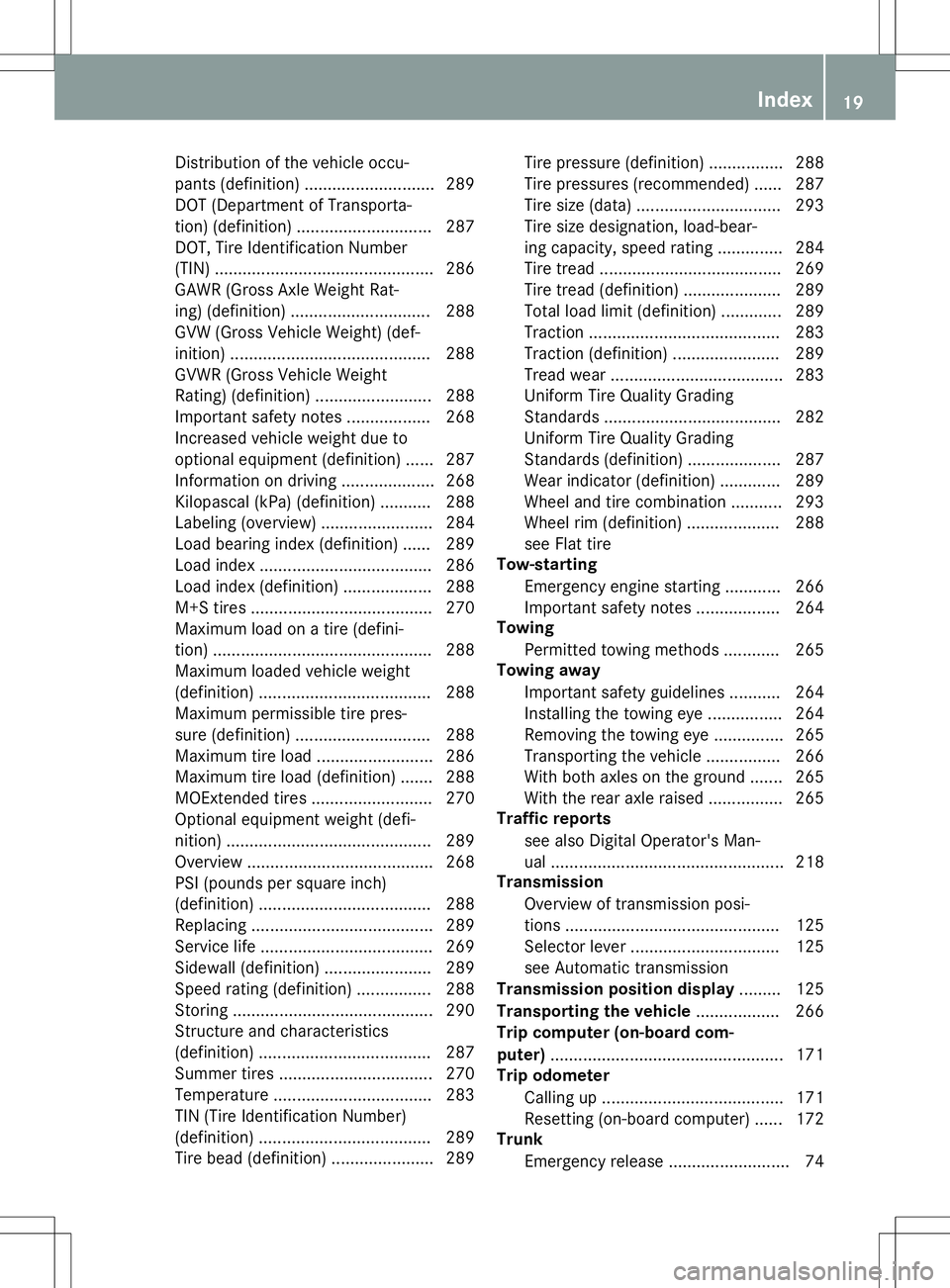
Dis
tribu tio no fthe veh icleo ccu -
pa nts (defi niti on) ............ ................289
DOT (Departme ntofTra nsp orta -
tio n)(defi niti on) ............ .................287
DOT, Tire Ide ntif icationN umber
(T IN) ............ ............ ....................... 286
GAW R(GrossA xle Weight Rat-
ing )(de finiti on) ............ ..................288
GV W( GrossV ehicleW eigh t)(def-
ini tio n)............ ............ ...................288
GV WR (Gros sVehicleW eigh t
Ra ting )(de finiti on) ............ .............288
Importa ntsafe tynotes .................. 268
Increase dvehi cle weight due to
optio nalequ ipme nt(de finitio n)...... 287
Informati onondrivi ng....... ............. 268
Kil opa scal (kPa)(de finitio n)....... .... 288
Lab eling (ove rview ).<0011001100110011001100110011001100110011001100110011001100110011
0011001100110011001100110011[ 284
Loa dbearing index(defi niti on) ...... 289
Loa dind ex <0011001100110011001100110011001100110011001100110011001100110011
0011001100110011001100110011001100110011001100110011001100110011
00110011001100110011> 286
Loa dind ex (defi niti on) <0011001100110011001100110011001100110011001100110011001100110011
001100110011[ 288
M+S tires.<0011001100110011001100110011001100110011001100110011001100110011
0011001100110011001100110011001100110011001100110011001100110011
001100110011001100110011> 270
Ma ximu mloado na tire (defi ni-
tion) <0011001100110011001100110011001100110011001100110011001100110011
0011001100110011001100110011001100110011001100110011001100110011
001100110011001100110011001100110011001100110011001100110011> 288
Ma ximu mloaded vehiclew eigh t
(d efi niti on) <0011001100110011001100110011001100110011001100110011001100110011
0011001100110011001100110011001100110011001100110011001100110011
00110011001100110011> 288
Ma ximu mpermi ssi blet ire pre s-
su re (defi niti on) <0011001100110011001100110011001100110011001100110011001100110011
0011001100110011001100110011001100110011001100110011[ 288
Ma ximu mtireload <0011001100110011001100110011001100110011001100110011001100110011
001100110011001100110011001100110011[ 286
Ma ximu mtireload (defi niti on) ....... 288
MOExte ndedtires.<0011001100110011001100110011001100110011001100110011001100110011
001100110011001100110011001100110011[ 270
Opti onalequ ipm ent weight (defi -
niti on) <0011001100110011001100110011001100110011001100110011001100110011
0011001100110011001100110011001100110011001100110011001100110011
001100110011001100110011001100110011001100110011> 289
Ove rview <0011001100110011001100110011001100110011001100110011001100110011
0011001100110011001100110011001100110011001100110011001100110011
00110011001100110011001100110011> 268
PSI (pou nds pers quare inch )
(d efi niti on) <0011001100110011001100110011001100110011001100110011001100110011
0011001100110011001100110011001100110011001100110011001100110011
00110011001100110011> 288
Re placi ng <0011001100110011001100110011001100110011001100110011001100110011
0011001100110011001100110011001100110011001100110011001100110011
0011001100110011001100110011> 289
Servi celife <0011001100110011001100110011001100110011001100110011001100110011
0011001100110011001100110011001100110011001100110011001100110011
00110011001100110011> 269
Sid ewall( de finiti on) <0011001100110011001100110011001100110011001100110011001100110011
0011001100110011001100110011[ 289
Spe edrati ng(defi niti on) ................ 288
Stori ng<0011001100110011001100110011001100110011001100110011001100110011
0011001100110011001100110011001100110011001100110011001100110011
00110011001100110011001100110011001100110011> 290
Structu reand characte ristics
(d efi niti on) <0011001100110011001100110011001100110011001100110011001100110011
0011001100110011001100110011001100110011001100110011001100110011
00110011001100110011> 287
Sum mer tires.<0011001100110011001100110011001100110011001100110011001100110011
0011001100110011001100110011001100110011001100110011001100110011[ 270
Tem peratu re<0011001100110011001100110011001100110011001100110011001100110011
0011001100110011001100110011001100110011001100110011001100110011
00110011> 283
TIN (Tire Identifi cationNumbe r)
(d efi niti on) <0011001100110011001100110011001100110011001100110011001100110011
0011001100110011001100110011001100110011001100110011001100110011
00110011001100110011> 289
Ti re bead (defi niti on) <0011001100110011001100110011001100110011001100110011001100110011
001100110011001100110011[ 289Ti
re pre ssu re(defi niti on) ................ 288
Ti re pre ssu res (recomme nded)...... 287
Ti re size (data ).<0011001100110011001100110011001100110011001100110011001100110011
00110011001100110011001100110011001100110011001100110011[ 293
Ti re size designa tion, load -be ar-
ing capacity, spe edrati ng.............. 284
Ti re trea d.<0011001100110011001100110011001100110011001100110011001100110011
0011001100110011001100110011001100110011001100110011001100110011
001100110011001100110011> 269
Ti re trea d(definiti on) <0011001100110011001100110011001100110011001100110011001100110011
00110011001100110011[ 289
Tota lloa dlim it(d efi niti on) ............. 289
Tra ctio n.<0011001100110011001100110011001100110011001100110011001100110011
0011001100110011001100110011001100110011001100110011001100110011
00110011001100110011001100110011> 283
Tra ctio n(definiti on) <0011001100110011001100110011001100110011001100110011001100110011
0011001100110011001100110011[ 289
Tre adwear<0011001100110011001100110011001100110011001100110011001100110011
0011001100110011001100110011001100110011001100110011001100110011
00110011001100110011> 283
Unif orm Tire Qua lity Gra ding
Stand ards.<0011001100110011001100110011001100110011001100110011001100110011
0011001100110011001100110011001100110011001100110011001100110011
00110011001100110011> 282
Unif orm Tire Qua lity Gra ding
Stand ards(de finiti on) <0011001100110011001100110011001100110011001100110011001100110011
0011001100110011[ 287
Wea rind ica tor (defi niti on) ............. 289
Whe eland tirecomb ination ........... 293
Whe elrim (defi niti on) <0011001100110011001100110011001100110011001100110011001100110011
0011001100110011[ 288
see Flattire
Tow -starti ng
Emerg encyenginestarting ............ 266
Imp orta ntsafety notes <0011001100110011001100110011001100110011001100110011001100110011
00110011[ 264
Tow ing
Per mitte dtow ing meth ods............ 265
Tow inga way
Imp orta ntsafety guideline s........... 264
Insta lling the towingeye. ............... 264
Re movi ngthe towingeye. .............. 265
Tra nspo rting thevehicle. ............... 266
Wi th both axles on the ground ....... 265
Wi th the rearaxler aised ................ 265
Traffi crepo rts
see also Digi talOpe rator'sMan-
ua l.<0011001100110011001100110011001100110011001100110011001100110011
0011001100110011001100110011001100110011001100110011001100110011
0011001100110011001100110011001100110011001100110011001100110011
0011[ 218
Trans mission
Ove rview oftrans mission pos i-
tions <0011001100110011001100110011001100110011001100110011001100110011
0011001100110011001100110011001100110011001100110011001100110011
00110011001100110011001100110011001100110011001100110011> 125
Sel ector lever <0011001100110011001100110011001100110011001100110011001100110011
0011001100110011001100110011001100110011001100110011001100110011[ 125
see Auto matictrans mission
Trans missionp osition display ......... 125
Transporti ngthe vehic le<0011001100110011001100110011001100110011001100110011001100110011
00110011[ 266
Trip computer (on-b oard com-
puter) <0011001100110011001100110011001100110011001100110011001100110011
0011001100110011001100110011001100110011001100110011001100110011
0011001100110011001100110011001100110011001100110011001100110011
00110011[ 171
Trip odomete r
Ca lling up<0011001100110011001100110011001100110011001100110011001100110011
0011001100110011001100110011001100110011001100110011001100110011
0011001100110011001100110011> 171
Re setti ng(on-boa rdcomp uter)...... 172
Trunk
Emerg encyrelease <0011001100110011001100110011001100110011001100110011001100110011
0011001100110011001100110011001100110011[ 74 In
dex
19
Page 25 of 310

Protecting
theenvironment General
notes H
Environmental
note
Daimler's declaredpolicyisone ofcompre-
hensive environm entalprotect ion.
The object ivesareforthe natural resources
that form thebasis ofour existen ceon this
planet tobe used sparingly andinam anner
that takes therequirements ofboth nature
and humanity intoaccount.
You toocan help toprotect theenvironm ent
by operating yourvehicle inan environm en-
tally responsible manner.
Fuel consumpt ionand therate ofengine,
transm ission,brakeandtirewear areaffec-
ted bythese factors:
R operating conditionsofyour vehicle
R your personal drivingstyle
You caninfluence bothfactors. Youshould
bear thefollowing inmind:
Operating conditions:
R avoid shorttripsasthese increase fuel
consumpt ion.
R alwa ysmake surethatthetire pressures
are correct .
R do not carry anyunnecessary weight.
R remove roofracks onceyounolonger
need them.
R ar egularly serviced vehiclewillcont ribute
to environm entalprotect ion.You should
therefore adheretothe service intervals.
R alwa yshave service workcarried outata
quali fiedspecialist workshop.
Personal drivingstyle:
R do not depress theaccelerator pedal
when startin gthe engine.
R do not warm upthe engine whenthevehi-
cle isstationary.
R drive carefully andmaintain asafe dis-
tance fromthevehicle infront .
R avoid frequent, suddenacceleration and
braking. R
change gearingood timeanduseeach
gear onlyupto00C3 ofits maximum engine
speed.
R switch offthe engine instationary traffic.
R keep aneye onthe vehicle's fuelcon-
sumption. Environmental
concerns andrecom-
mendat ions
Wherever theoperating instructionsrequire
you todispose ofmaterials, firsttrytoregen-
erate orre-use them.Observe therelevant
environm entalrulesandregulations whendis-
posing ofmaterials. Inthis way youwillhelp to
protect theenvironm ent. Genuine
Mercedes-Benz parts H
Environmental
note
Daimler AGalso supplie srecondit ioned
major assemblies andparts which areofthe
same qualityas new parts. Theyarecovered
by the same Limited Warranty entitlements
as new parts.
! Air
bags andEmergen cyTensioning Devi-
ces, aswell ascont rolunits andsensors for
these restraint systems, maybeinstalled in
the following areasofyour vehicle:
R doors
R door pillars
R door sills
R seats
R cock pit
R instrumen tcluster
R cent erconsole
Do not install accessories suchasaudio sys-
tems inthese areas. Donot carry out
repairs orwelding. Youcould impair the
operating efficiency ofthe restraint sys-
tems.
Have aftermark etaccessories installedata
quali fiedspecialist workshop.
You could jeopardize theoperating safetyof
your vehicle ifyou useparts, tiresandwheels
as well asaccessories relevanttosafety which Genuine
Mercedes-Benz parts
23Introdu ction Z
Page 43 of 310
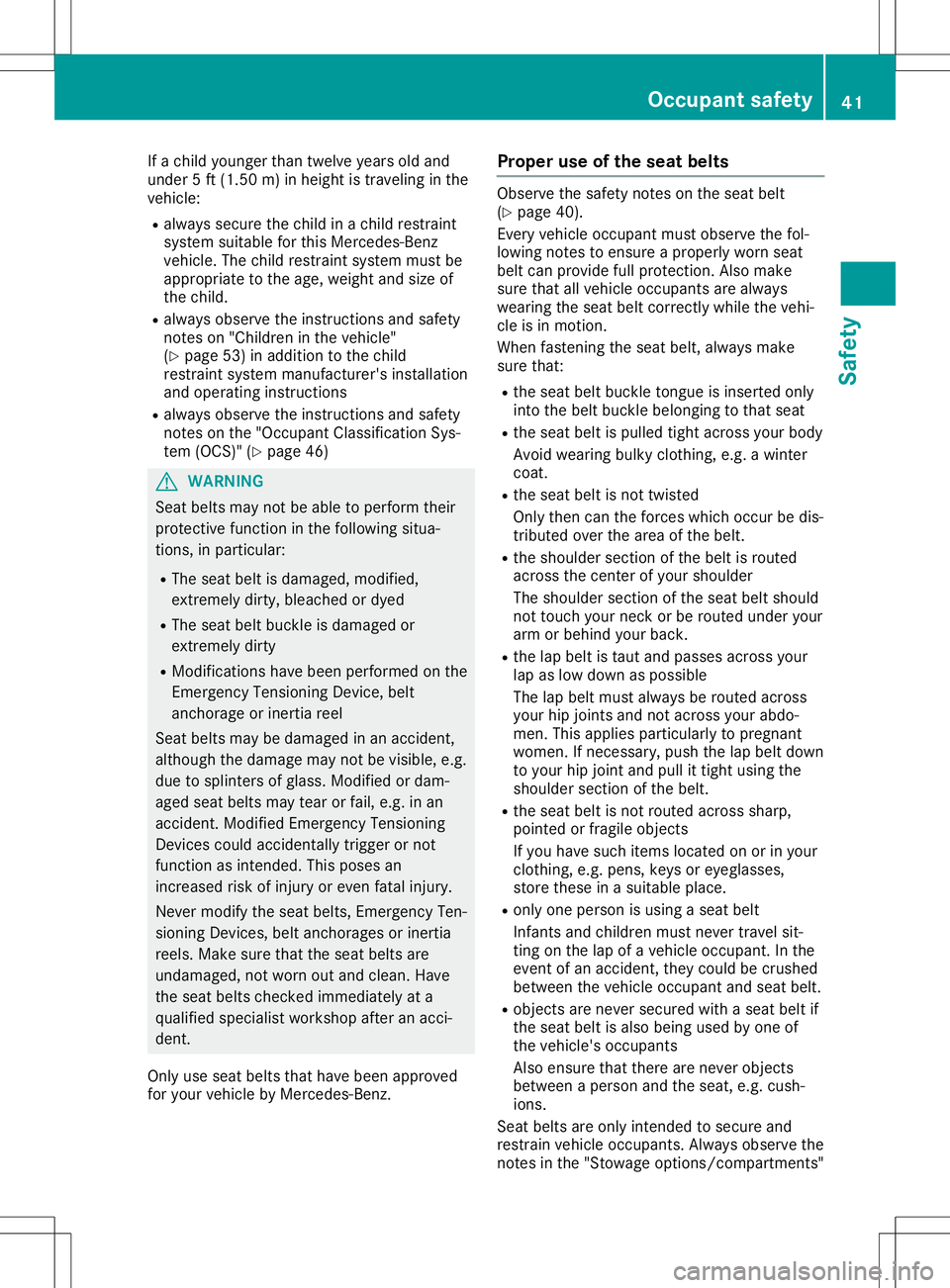
If
ac hild younger thantwelve yearsold and
under 5ft(1.5 0m )inh eight istravelin gint he
vehic le:
R always securethe child inac hild restraint
syst emsuitable forthis Merc edes- Benz
vehic le.The child restraint systemmust be
appropr iatetothe age, weight andsize of
the child.
R always observethe instruct ions andsafet y
not eson "Children inthe vehic le"
(Y page 53)inaddition tothe child
rest raint systemmanuf acturer' sinst allation
and operat inginst ruct ions
R always observethe instruct ions andsafet y
not eson the "Occ upant Classific ationSys-
tem (OCS)" (Ypage 46) G
WARN
ING
Seat belts maynotbeable toperf orm their
prot ective func tion inthe followin gsitua-
tion s,in part icular:
R The seat beltisdamaged, modified,
ext reme lydirt y,bleache dordyed
R The seat beltbuck leisdamaged or
ext reme lydirt y
R Modific ationshave been performe donthe
Em ergen cyTens ionin gDevice, belt
anc horage oriner tiareel
Seat belts maybedamaged inan acc ident ,
althoug hthe damage maynotbevisible, e.g.
due tosplint ersofglass. Modifie dordam-
aged seatbelts maytearorfail, e.g. inan
acc ident .Modifie dEmergen cyTens ionin g
Dev ices could accident allytrigger ornot
func tion asintended .This poses an
inc reased riskofinjury oreven fatalinj ury.
Never modifythe seat belts ,Eme rgen cyTen-
sion ingDev ices, beltanchorage soriner tia
reels. Make surethattheseat belts are
undamage d,not worn outand clean .Have
the seat belts checkedimmed iatelyata
qualified specialist workshop afteran acc i-
dent .
Only useseat belts thathave been approv ed
for your vehic leby Merc edes- Benz. Prop
eruse ofthes eat belts Obser
vethe safet ynotes on the seat belt
(Y page 40).
Ev ery vehic leocc upant mustobservethe fol-
lowing notestoens ure aproper lyworn seat
belt canprov idefull prot ection. Also make
sure thatallvehic leocc upant sarealways
wearing theseat beltcorrectlywhile thevehi-
cle isin mot ion.
When fastenin gthe seat belt, always make
sure that:
R the seat beltbuck leton gue isinse rted only
int ot he belt buck lebelon gingtothat seat
R the seat beltispulled tightacro ssyour body
Av oid wearin gbulky clothing ,e.g. aw inter
coat .
R the seat beltisnot twist ed
Only thencan the forces which occurbe dis-
tr ibuted overthearea ofthe belt.
R the shoulder sectionofthe belt isrout ed
acro ssthe centerofyour shoulder
The shoulder sectionofthe seat beltshould
not touc hyour neckorberout edunder your
arm orbehin dyour back .
R the lapbelt istaut andpasses acrossyour
lap aslow down aspossible
The lapbelt must always berout edacro ss
your hipjointsand notacro ssyour abdo-
men .This applies particularly topregn ant
women .Ifn ecessary, pushthelapbelt down
to your hipjointand pull ittigh tusing the
shoulder sectionofthe belt.
R the seat beltisnot rout edacro sssharp,
point edorfragile objects
If you have such itemslocat edon orinyour
clot hing ,e.g. pens ,keys oreyeglasses ,
sto rethe seinas uitable place.
R only oneperso nisu sing aseat belt
Inf ant sand childr enmust nevertravel sit-
tin go nthe lap ofav ehic leocc upant .Int he
even tofana ccident ,the yc ould becrus hed
betwee nthe vehic leocc upant andseat belt.
R obje ctsa renev ersecur edwith aseat belt if
the seat beltisalso being usedbyone of
the vehic le'soccupant s
Also ensure that thereare neverobje cts
betwee napersonand the seat, e.g.cush-
ions .
Seat belts areonly intended tosecur eand
rest rain vehic leocc upant s.Always observethe
not esinthe "Stowage options/com partmen ts" Occupa
ntsaf ety
41Safety Z
Page 48 of 310
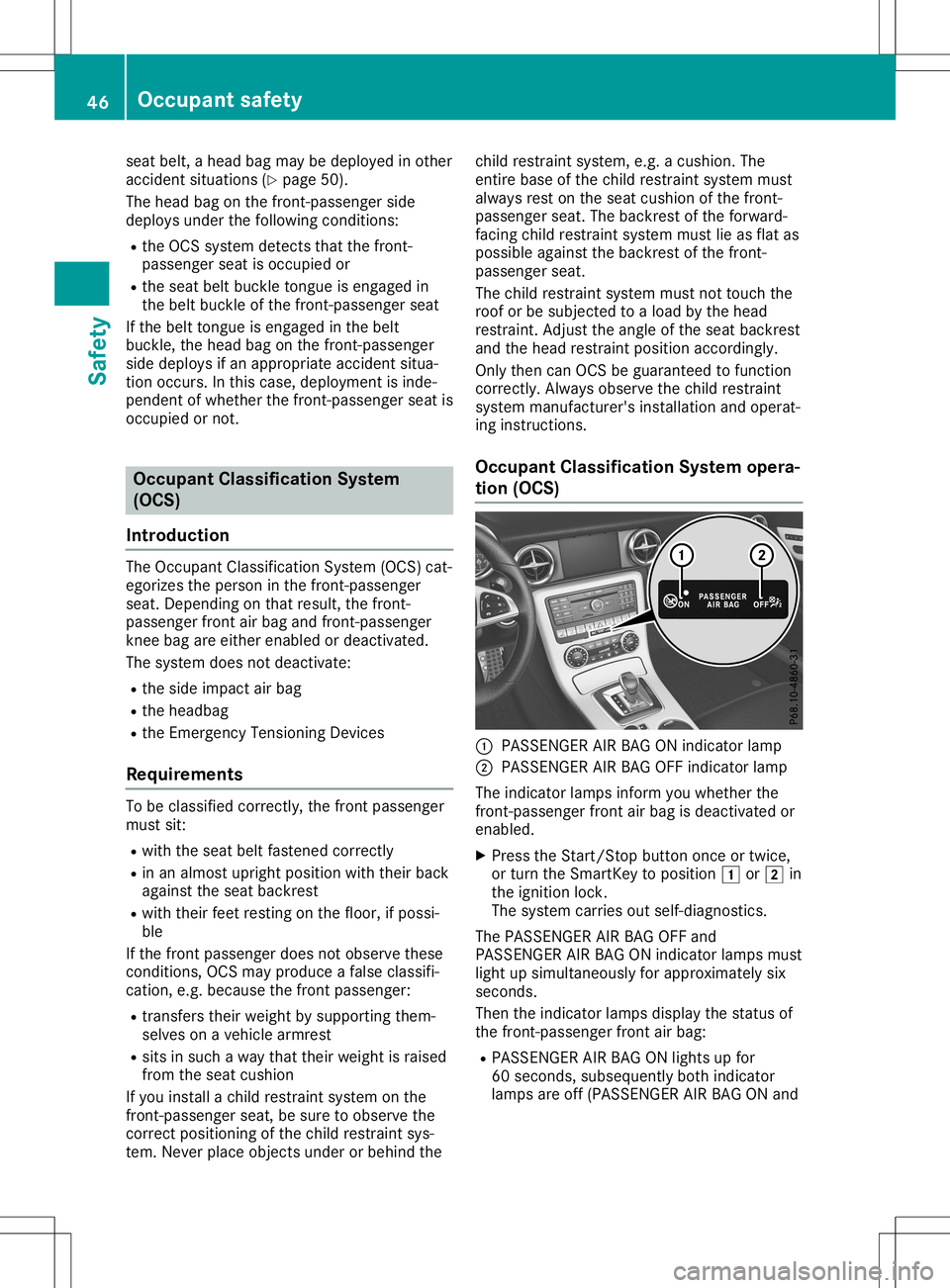
seat
belt, ahead bagmay bedeploy edinother
accident situations (Ypage 50).
The head bagonthe front -passenger side
deploy sunder thefollowi ngconditions:
R the OCS system detects thatthefront -
passenger seatisoccupied or
R the seat beltbuckle tongue isengaged in
the belt buckle ofthe front -passenger seat
If the belt tongue isengaged inthe belt
buckle, thehead bagonthe front -passenger
side deploy sifa na ppropria teaccident situa-
tion occurs. Inthis case, deploy mentisinde-
pendent ofwhether thefront -passenger seatis
occupied ornot. Occupant
ClassificationSystem
(OCS)
Introduction The
Occupant Classification System(OCS)cat-
egorizes theperson inthe front -passenger
seat. Depending onthat result, thefront -
passenger frontairbag and front -passenger
knee bagareeither enabled ordeactivated.
The system doesnotdeactivate:
R the side impact airbag
R the headba g
R the Emergenc yTensioning Devices
Requirements To
be classified correctly,the front passenger
must sit:
R with theseat beltfastened correctly
R in an almost upright position withtheir back
agai nstthe seat backrest
R with their feetresting onthe floor, ifpossi-
ble
If the front passenger doesnotobserve these
conditions, OCSmayproduce afalse classifi-
cation, e.g.because thefront passenger:
R transfers theirweight bysupporting them-
selves onavehicle armrest
R sits insuch awaythat their weight israised
from theseat cushion
If you install achild restraint systemonthe
front -passenger seat,besure toobserve the
correct positioning ofthe child restraint sys-
tem. Never placeobjects underorbehind the child
restraint system,e.g.acushion. The
entire baseofthe child restraint systemmust
alwa ysrest onthe seat cushion ofthe front -
passenger seat.Thebackrest ofthe forward-
facing childrestraint systemmustlieasflat as
possible againstthe backrest ofthe front -
passenger seat.
The child restraint systemmustnottouch the
roof orbe subjected toaload bythe head
restraint. Adjusttheangle ofthe seat backrest
and thehead restraint positionaccordingly.
Only thencanOCS beguara nteed tofunction
correct ly.Always observe thechild restraint
system manufacturer's installationandoperat-
ing instruct ions.
Occupant ClassificationSystem opera-
tion (OCS) 0043
PASSE NGERAIRBAG ONindicator lamp
0044 PASSE NGERAIRBAG OFFindicator lamp
The indicator lampsinform youwhether the
front -passenger frontairbag isdeactivated or
enabled.
X Press theStart/ Stopbutton onceortwice,
or turn theSmartKey toposition 0047or0048 in
the ignition lock.
The system carriesout<00560048004F004900100047004C0044004A0051005200560057004C00460056
0011[
The PASSE NGERAIRBAG OFFand
PASSE NGERAIRBAG ONindicator lampsmust
light upsimultaneousl yfor approximately six
seconds.
Then theindicator lampsdisplaythe status of
the front -passenger frontairbag:
R PASSE NGERAIRBAG ONlights upfor
60 seconds, subsequentlybothindicator
lamps areoff(PASSE NGERAIRBAG ONand 46
Occ
upant safetySafety
Page 52 of 310
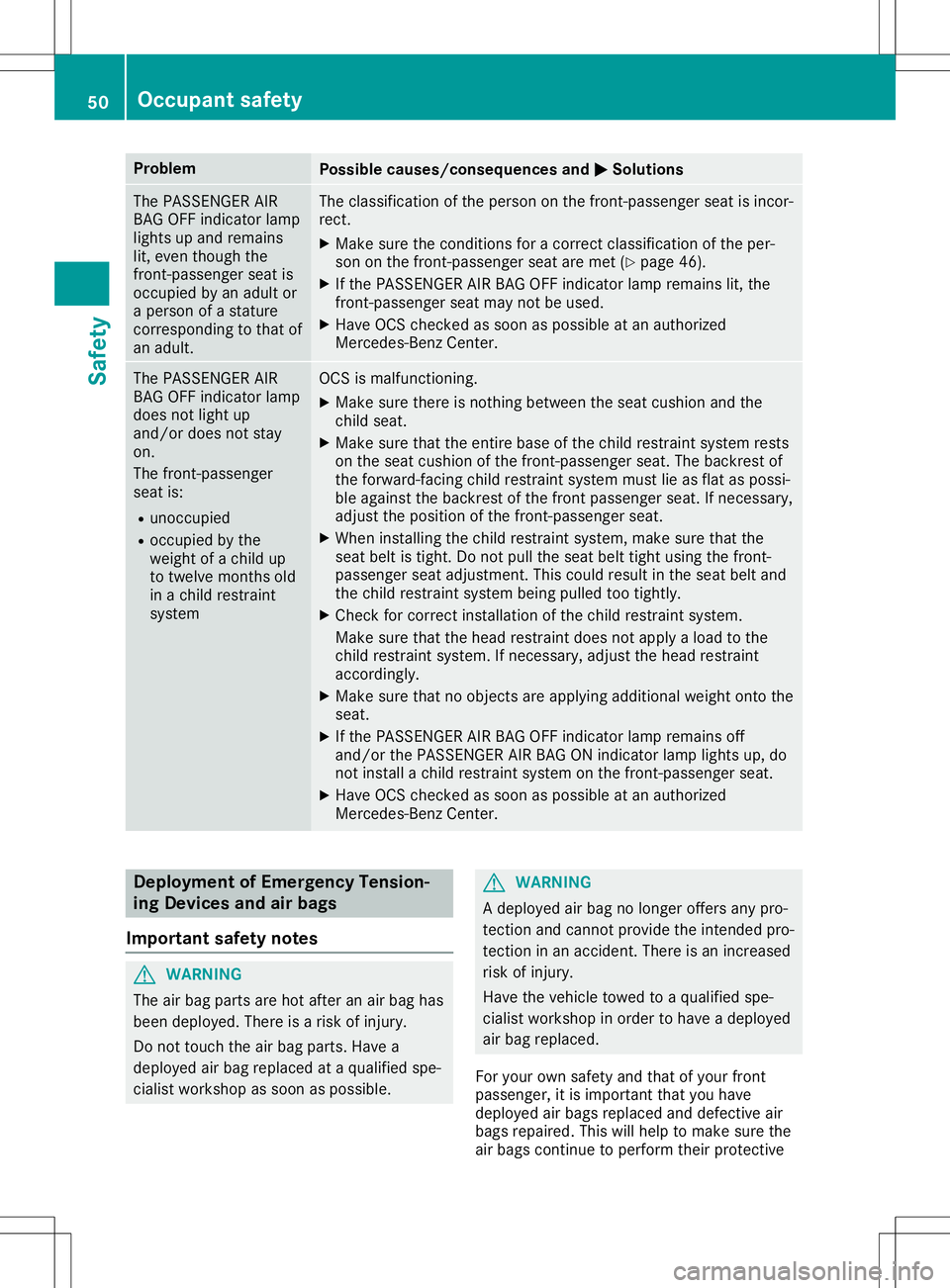
Problem
Possible
causes/co nsequences and0050 0050
Solutions The
PASS ENGER AIR
BAG OFFindicator lamp
lights upand remains
lit, even though the
front -passenger seatis
occupied byan adult or
ap erson ofas tature
correspondin gtot hat of
an adult. The
classification ofthe person onthe front -passenger seatisincor-
rect.
X Make surethecondition sfor ac orrect classification ofthe per-
son onthe front -passenger seataremet (Ypage 46).
X Ifthe PASS ENGER AIRBAG OFFindicator lampremains lit,the
front -passenger seatmaynotbeused.
X Have OCScheck edassoon aspossible atan authorized
Mercedes-Ben zCenter. The
PASS ENGER AIR
BAG OFFindicator lamp
does notlight up
and/or doesnotstay
on.
The front -passenger
seat is:
R unoccupied
R occupied bythe
weight ofac hild up
to twelve monthsold
in ac hild restraint
system OCS
ismalfunctionin g.
X Make surethere isnothin gbetween theseat cushion andthe
child seat.
X Make surethattheentire baseofthe child restraint systemrests
on the seat cushion ofthe front -passenger seat.Thebackrest of
the forward-facing childrestraint systemmustlieasflat aspossi-
ble against thebackrest ofthe front passenger seat.Ifnecessary,
adjust theposition ofthe front -passenger seat.
X When installing thechild restraint system,makesurethatthe
seat beltistight. Donot pull theseat belttight using thefront -
passenger seatadjustment .This could result inthe seat beltand
the child restraint systembeingpulled tootightly.
X Check forcorrect installation ofthe child restraint system.
Make surethatthehead restraint doesnotapply aload tothe
child restraint system.Ifnecessary, adjustthehead restraint
accordingly.
X Make surethatnoobject sareapply ingadditional weightontothe
seat.
X Ifthe PASS ENGER AIRBAG OFFindicator lampremains off
and/or thePASS ENGER AIRBAG ONindicator lamplights up,do
not install achild restraint systemonthe front -passenger seat.
X Have OCScheck edassoon aspossible atan authorized
Mercedes-Ben zCenter. Deployment
ofEmergency Tension-
ing Devic esand airbags
Import antsafety notes G
WARNING
The airbag parts arehot after anair bag has
been deploye d.There isar isk ofinjury.
Do not touch theairbag parts. Havea
deploye dairbag replaced ataq uali fied spe-
cialist workshop assoon aspossible. G
WARNING
Ad eploye dairbag nolonger offersanypro-
tect ionand cannot provide theinten dedpro-
tect ioninan accident. Thereisan increased
risk ofinjury.
Have thevehicle towedtoaq uali fied spe-
cialist workshop inorder tohave adeploye d
air bag replaced.
For your ownsafety andthat ofyour front
passenger, itis important thatyouhave
deploye dairbags replaced anddefective air
bags repaired. Thiswillhelp tomake surethe
air bags continue toperform theirprotect ive 50
Occ
upantsafetySafety
Page 266 of 310
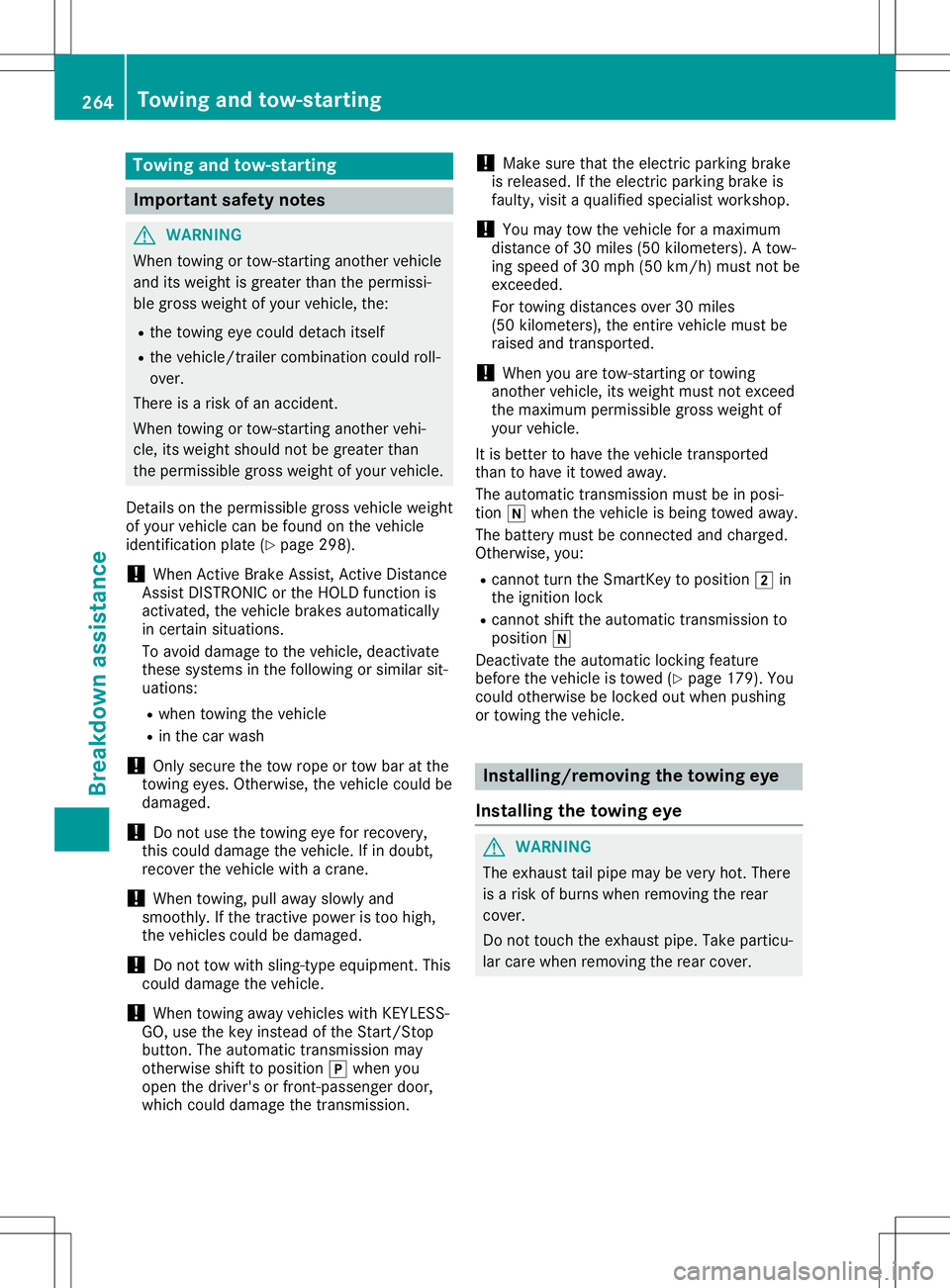
Tow
inga nd tow -starti ng Impo
rtant safety notes G
WA
RNING
Wh entow ingortow -sta rtinganothe rvehicle
and itsweight isgre atertha nt he permi ssi-
bl eg ross we ight ofyour veh icle, the :
R the towingeyec ouldde tach itself
R the vehicle/tra iler comb inationc ouldrol l-
ove r.
The reisar isko fana ccident.
Wh entow ingortow -sta rtinganothe rvehi-
cle ,its we ight sho uldn otbe gre atertha n
the permi ssibleg ross we ight ofyour veh icle.
Deta ilso nthe permi ssibleg ross veh iclew eigh t
of your veh iclec an be fou ndonthe vehicle
id enti ficati on plate (Ypage 298 ).
! Wh
enActiv eBrake Assi st,Activ eDistance
Assi stDISTR ONICorthe HOLD functio nis
acti vated ,the veh icleb rakes automa tically
in certa insitua tions.
To avoidd amaget ot he veh icle, de acti vate
the sesystem sint he followi ng orsimil arsit-
ua tio ns:
R wh en tow ingthe vehicle
R in the carwash
! Onl
ysecuret he tow ropeortow bara tthe
tow ingeyes. Othe rwise, the vehiclec ouldbe
da ma ged.
! Do
not uset he tow ingeyef or reco very,
thi sc ouldda ma gethe vehicle. Ifin do ubt,
reco verthe vehiclew ithac rane.
! Wh
entow ing,pulla wa yslowly and
smo othly.Ifthe tractiv epoweristoo high,
the vehicles cou ldbe dama ged.
! Do
not tow with sling -typ eequipm ent.This
cou ldda ma gethe vehicle.
! Wh
entow ingaway veh icles with KEYL ESS-
GO ,use the key instea dofthe Star t/Stop
bu tton. Theautoma tictransmi ssion may
othe rwises hift to positio n005D when you
op en the driver 'sor fro nt-pa ssenge rdoor,
wh ich cou ldda ma gethe transmi ssion. !
Ma
kesure tha tthe electri cparkin gb rake
is rel eased .Ift he electri cparkin gb rake is
fa ulty, visitaq ualifi ed speci alistw orksh op.
! Yo
um aytow thevehiclef or am axim um
di sta nce of30 miles(50 kilome ters).At ow -
ing spee do f30m ph(50 km/h )mustn ot be
exce eded.
For towingdista nces over30m iles
(50 kilome ters),the entireveh iclem ustb e
ra ised and transp orte d.
! Wh
enyoua retow -sta rtingortow ing
ano thervehicle, its weight mu stnot exce ed
the maxim um permi ssibleg ross we ight of
yo ur veh icle.
It is be tter tohave the vehiclet ransp orte d
tha ntoh avei ttow ed away.
The automa tictransmi ssion mu stbe inpo si-
tio n005C when the vehiclei sb eing tow edaway.
The battery mustbe conne ctedandcharged.
Othe rwise, you:
R canno tturnt he Sma rtKeytop ositio n 0048 in
the igniti onlock
R canno tshift the automa tictransmi ssion to
po sitio n005C
Dea ctivate the automa ticlocking feature
be for ethe veh iclei st ow ed (Ypage 179 ).Yo u
cou ldothe rwiseb eloc ked outw henp ushing
or tow ingthe vehicle. In
stal ling /re mov ingt he tow inge ye
In stal ling the towinge ye G
WA
RNING
The exhaust tai lpipem aybe veryhot. The re
is ar isko fburns when rem oving the rear
cove r.
Do not touchthe exhaust pipe .Takep artic u-
la rc arew henr em oving the rearcove r. 26
4 Tow
inga nd tow -starti ngBreak downassistanc e
Page 282 of 310
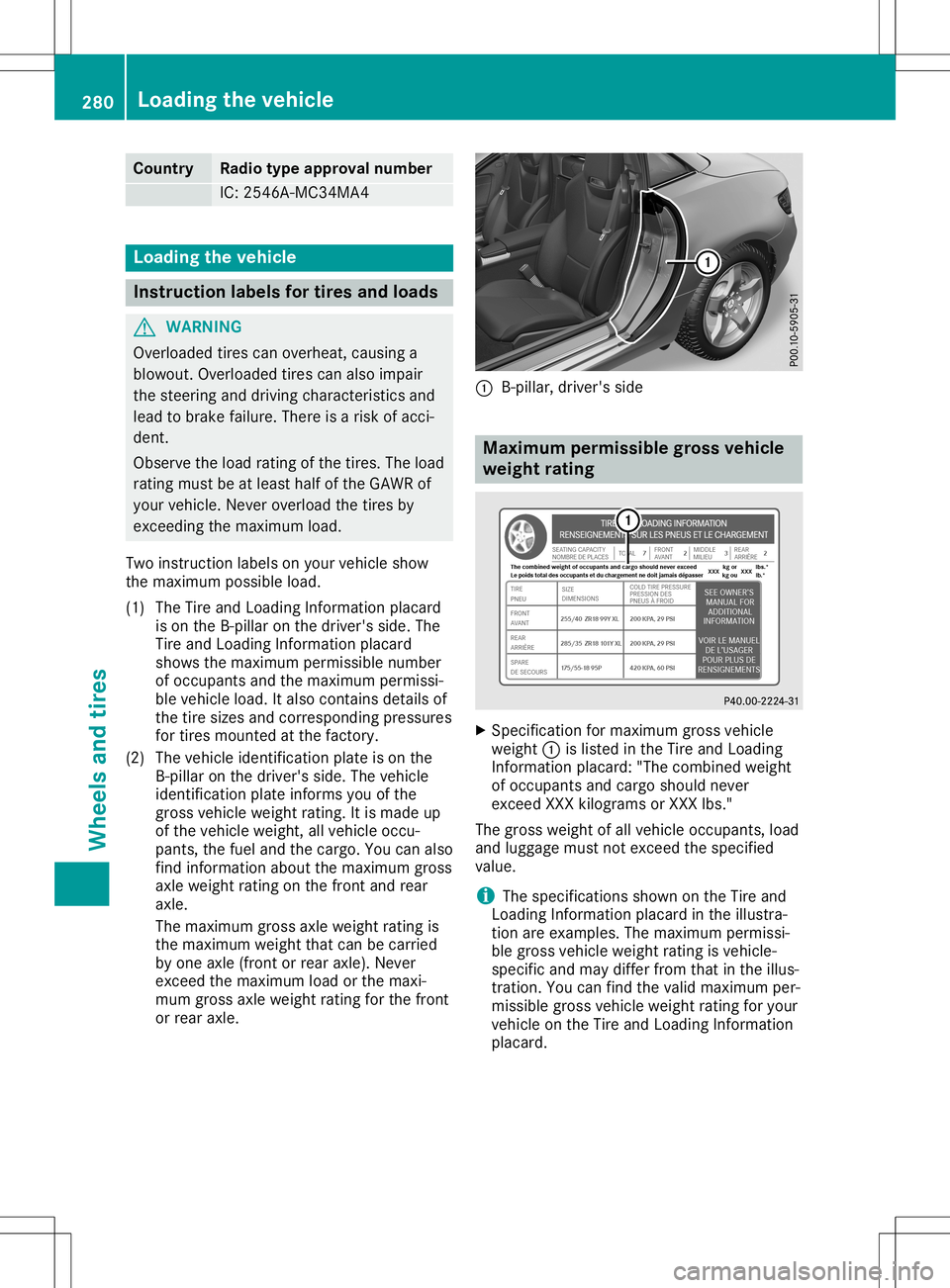
Count
ry Ra
dio type approval number IC:
2546A-MC34 MA4 Load
ingthev ehicle Inst
ruction labels fortires and loads G
WAR
NING
Ove rloade dtires can over heat ,causi nga
blowout .Overloade dtires can also impair
th es teerin gand driv ingchar acteris ticsa nd
lead tobrak efailur e.Ther eisar iskofacc i-
den t.
Obse rvethel oad rating ofthet ires. The load
rat ing must beatleast halfoftheG AWR of
your vehicle.Never over load thet ires by
exc eedin gthe max imum load.
Two instruct ion labels onyour vehicle show
th em aximum possibleload.
(1) TheTire andLoadin gInfor mat ionplacar d
is on theB -pillar onthed river' ss ide. The
Tire andLoadin gInfor mat ionplacar d
shows them aximum permissiblenum ber
of occ upant sand them aximum permissi-
ble vehicle load. Italso contain sdetails of
th et ires izes and correspon ding pressures
for tires moun tedatthef actory.
(2) Thevehicle iden tificat ion plat eiso nthe
B- pillar onthed river' ss ide. Thevehicle
iden tificat ion plat einform syou ofthe
gro ssveh icle weight rating .Iti sm ade up
of thev ehicle weight ,allveh icle occu-
pant s,thef uel and thec argo. You canalso
fin dinform ationabout them aximum gross
axle weight rating onthef ront and rear
axle.
The maximum grossaxle weight rating is
th em aximum weight that can becar ried
by one axle (front orrear axle) .Never
exc eed them aximum loadorthem axi-
mum grossaxle weight rating forthef ront
or rear axle. 0043
B-pillar ,driver' ss ide Ma
xim um permis sible grossvehicle
weight ratin g X
Spe cificat ion formax imum grossveh icle
weight 0043islist ed intheT ire and Loadin g
In for mat ionplacar d:"The combinedweight
of occ upant sand car goshould never
exc eed XXX kilogram sorXXX lbs. "
The grossweight ofall veh icle occupant s,load
and luggage mustnotexceed thes pec ified
value.
i The
spec ificatio nsshown ontheT ire and
Loadin gInfor mat ionplacar dint he illust ra-
tio na reexam ples.Themaximum permissi-
ble grossveh icle weight rating isveh icle-
spec ificand may differfro mt hatint he illus-
tr atio n.You canfindt he valid maximum per-
miss iblegrossveh icle weight rating foryour
veh icle ontheT ire and Loadin gInfor mat ion
placar d. 280
Load
ingthev ehicleWh eels andtires